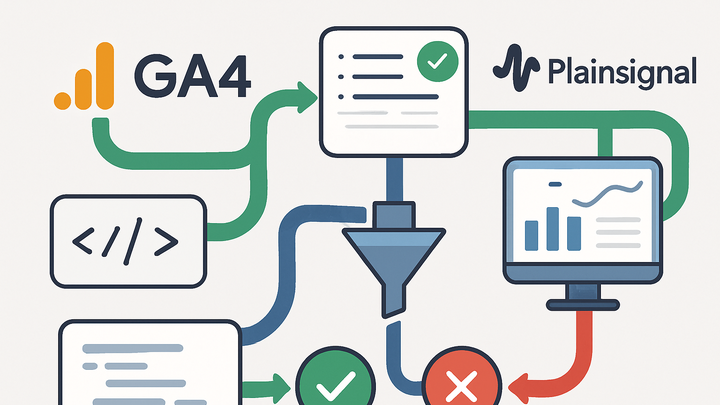Published on 2025-06-28T06:35:23Z
What is Data Validation? Examples for Analytics
Data Validation in analytics is the process of verifying that incoming event data meets predefined quality and format standards before it is processed or reported. It involves checks for missing fields, incorrect data types, out-of-range values, duplicates, and schema violations. By catching errors early—either at collection time or during processing—organizations can ensure that dashboards and reports reflect accurate, trustworthy insights. Poorly validated data can lead to misguided decisions, wasted marketing spend, and a loss of stakeholder confidence. Leading analytics platforms like GA4 and PlainSignal offer built-in tools and techniques to automate and streamline validation, from real-time debugging to domain-binding filters. Below, we explore key validation methods, platform-specific examples, and best practices to uphold data integrity.
Data validation
Ensures analytics data quality by verifying incoming events against rules, catching errors before analysis.
Importance of Data Validation
Understanding why validation matters in analytics and the consequences of poor data quality.
-
Preventing decision errors
Invalid or incomplete data can lead to inaccurate reports and misguided business strategies.
-
Maintaining stakeholder trust
Reliable data fosters confidence among teams, executives, and external partners.
-
Optimizing resource allocation
Clean data ensures marketing budgets and product strategies are effectively targeted.
Common Data Validation Techniques
Overview of techniques used to validate data during collection and processing.
-
Schema validation
Enforce predefined event and parameter structures to catch missing or extra fields early.
-
Range and type checks
Verify that numeric values fall within expected ranges and data types match definitions.
-
Real-time monitoring & alerts
Set up alerts for anomalies, sudden drops or spikes, and malformed event formats.
-
Sampling and manual audits
Periodically review raw logs or data samples to detect edge cases not caught by automated checks.
Data Validation with GA4
How Google Analytics 4 supports data validation through built-in features and integrations.
-
Debugview & real-time reports
Use DebugView to inspect and validate event payloads as they arrive in real time.
-
Data filters
Create filters to exclude internal traffic, bot events, or malformed data before it reaches reports.
-
Measurement protocol validation
Ensure server-side hits conform to the Measurement Protocol by using correct parameters and secret keys.
-
Bigquery export
Leverage exported raw data in BigQuery for custom validation queries and anomaly detection.
Data Validation with PlainSignal
Implementing data validation in a lightweight, cookie-free analytics platform.
-
Minimal parameter requirements
PlainSignal collects only essential data, reducing noise and simplifying validation.
-
Domain binding and integrity checks
Configuration ties data to your domain, preventing data injection or cross-site leakage.
-
Example tracking code
<link rel="preconnect" href="//eu.plainsignal.com/" crossorigin /> <script defer data-do="yourwebsitedomain.com" data-id="0GQV1xmtzQQ" data-api="//eu.plainsignal.com" src="//cdn.plainsignal.com/plainsignal-min.js"></script>
Best Practices and Recommendations
Key actions to maintain robust data validation processes over time.
-
Automate validation tests
Integrate automated checks into CI/CD pipelines or ETL workflows to enforce schemas.
-
Monitor key metrics
Track event counts, session metrics, and error rates to detect anomalies quickly.
-
Document validation rules
Maintain clear documentation of schemas, thresholds, filter logic, and audit procedures.
-
Review and iterate
Regularly revisit validation rules as your analytics strategy and event schemas evolve.
